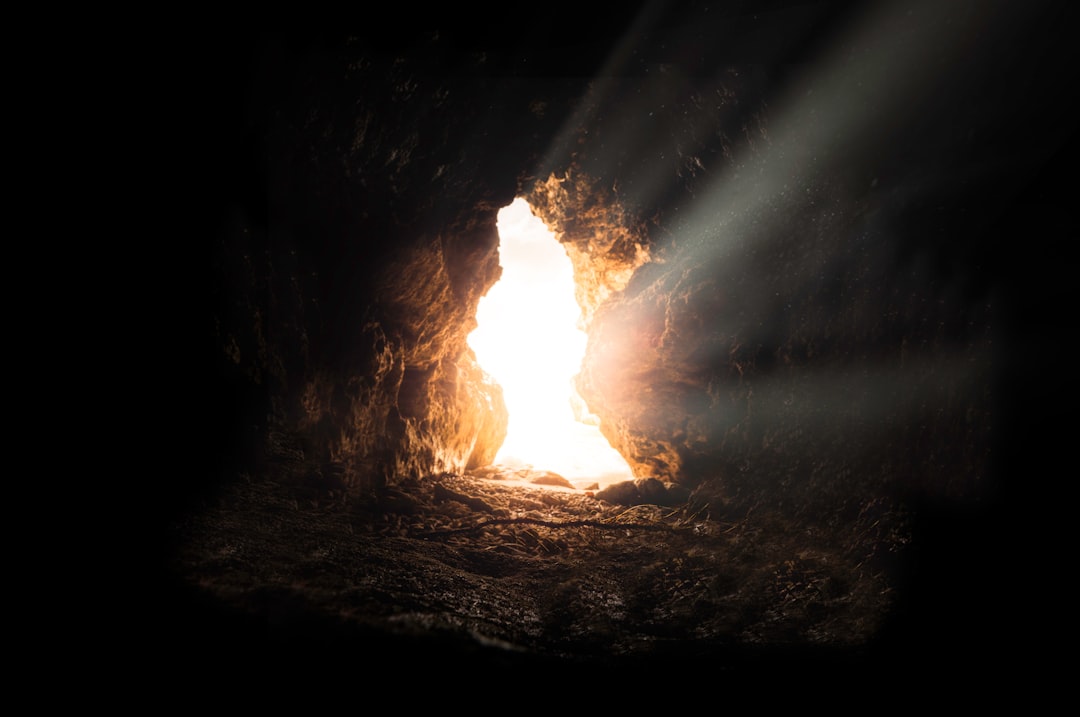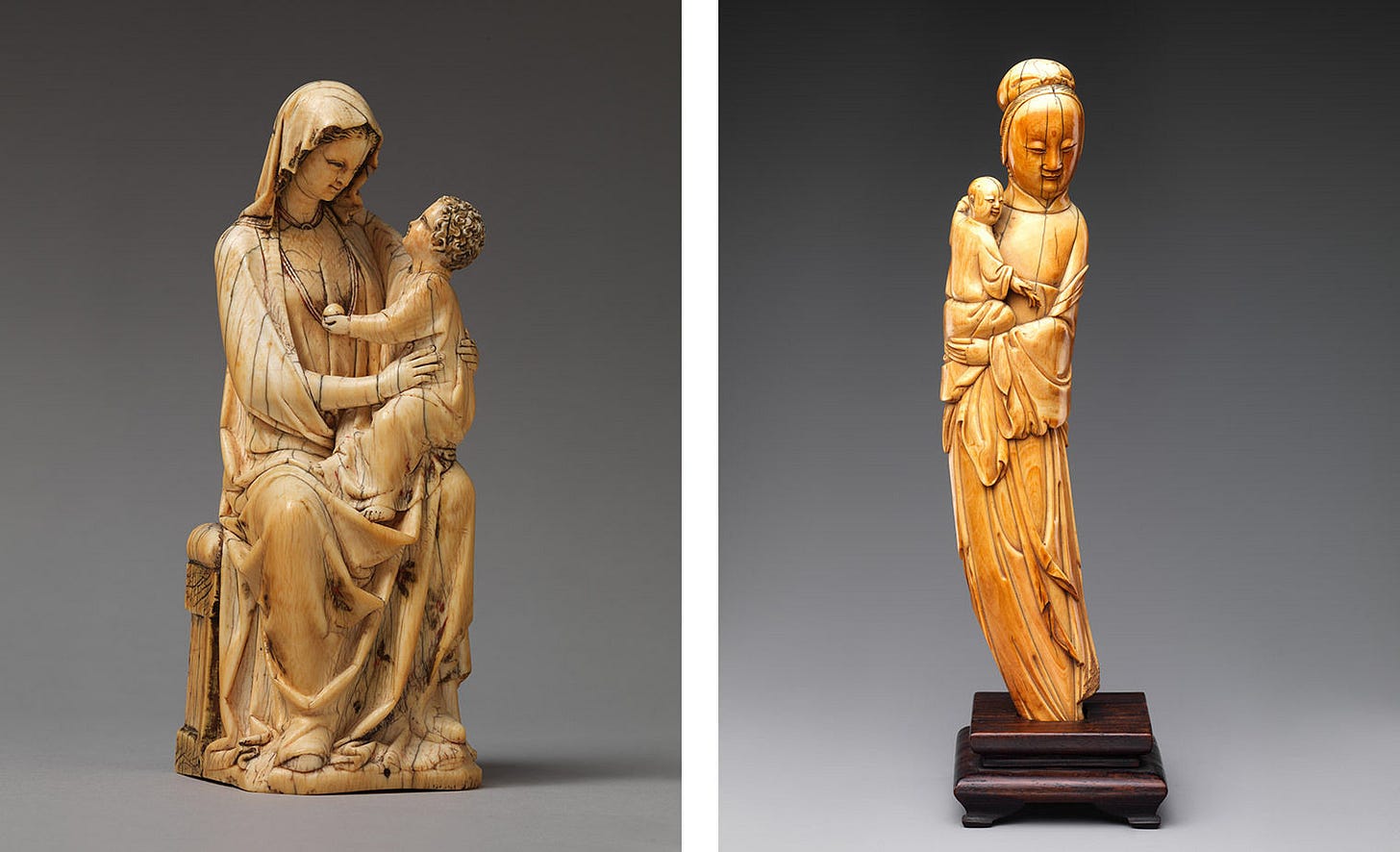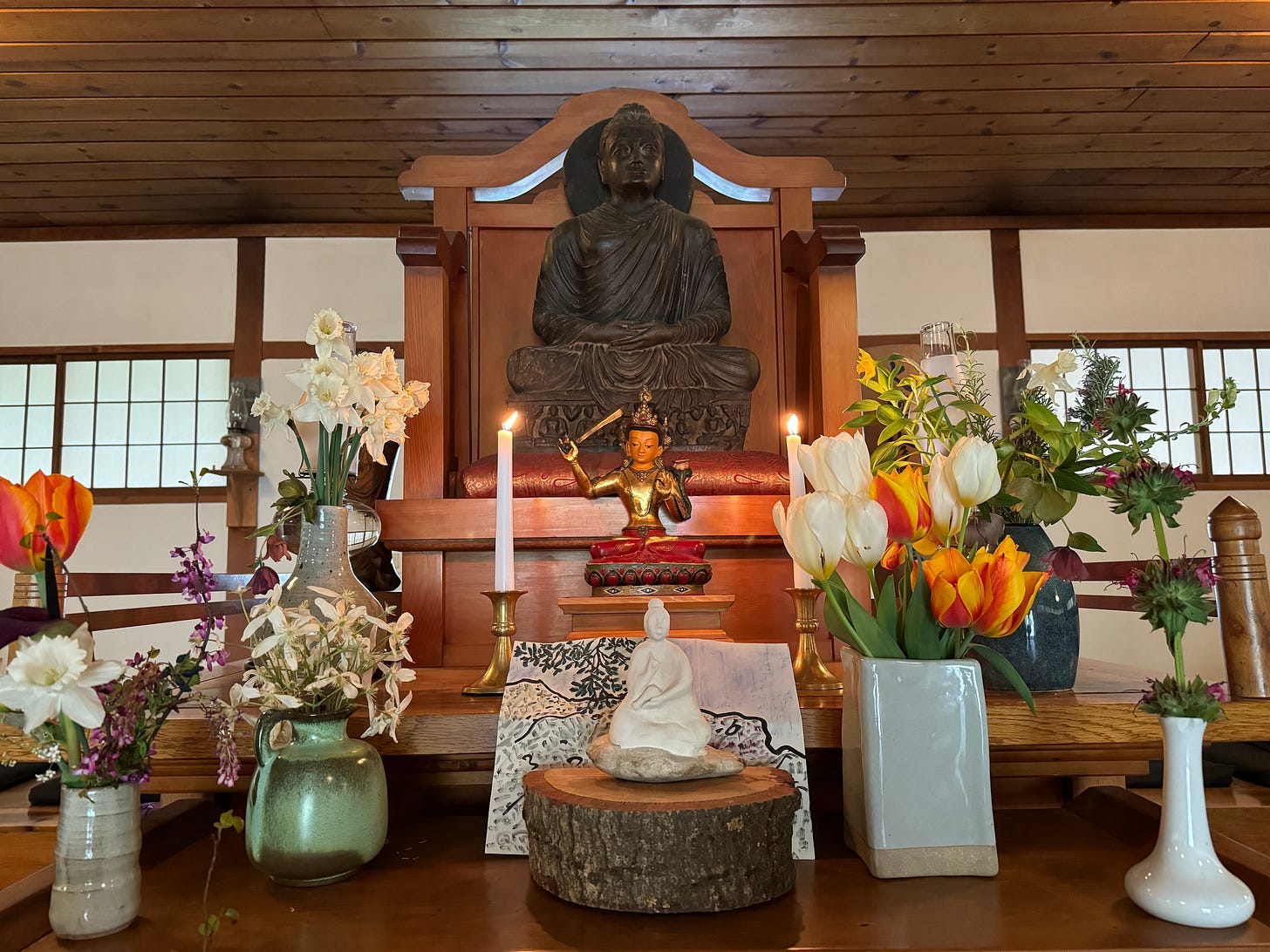
As I begin this post, it’s 8:00 AM on Good Friday. I confess, as even Roaming Catholics are wont to do, that I’ve not thought about the Holy Week of Easter in a long time. However, during our morning service—akin to a Catholic Mass sans the Body and Blood of Christ—thoughts of Easter arose in my mind. As the officiating Zen priest, I stood, knelt, and prostrated on a bowing mat before the altar in the center of the meditation hall.
Our altar, which is pictured above, is usually not adorned with so many flowers or the white Guanyin statue on the wood plinth and the watercolor painting behind it. These were crafted by Caroline Meister, a 32-year-old resident of Tassajara who died in a tragic hiking accident last week on a trail not far from the monastery. The tulips, narcissus, daffodils, redbud, and sage arranged on the altar are all from the monastery grounds, which Caroline was the head of last year. Though not depicted, there is a framed photograph of a smiling Caroline on the altar. Her friends offered malas, candles, and poems to commemorate her life and death, to express their love and grief.
For me, it’s always a powerful experience to face the altar, prostrate, and chant. But standing and facing this homage to Caroline on the morning of Good Friday, was even more sacred and poignant. It had been a week since Caroline’s body was found at the base of a waterfall. Prostrating over and over on the bowing mat, I surrendered to the universal, eternal, and omnipresent Buddha Nature that exists in sentient and non-sentient beings—that flows through the living and the dead.
Perhaps thoughts of Easter Sunday floated through the ether of my mind during service because I had spent several hours on Holy Wednesday (March 27th) visiting with Caroline’s mother Jean who is a devout Catholic. Although we talked about Catholicism because that was a common root for us, she never mentioned Easter. Jean told me about how she worked her way through college, became an editor at the Chicago Tribune and then the LA Times, about how artistic and kind Caroline was and how much her daughter loved nature.
Caroline’s parents arrived at Tassajara during the afternoon of Wednesday, March 20th. They arrived a few hours after I returned from participating in a five-day workshop at Green Gulch Farm. Given that I had just found myself in the middle of intense search and rescue (SAR) efforts, I had no time to spend with them.
Almost immediately after I arrived, I reluctantly agreed to an interview with a TV reporter. Then I spent the next two days continuously shuttling between the SAR incident command post in the parking lot, to our makeshift comms area in the dining room, to my director’s office. Responding as best I could to people’s concerns and queries, and supporting the compassionate, extraordinary, and indomitable Tassajara residents who poured their hearts and souls into assisting the SAR efforts, caring for the monastery, preparing meals for everyone, and comforting each other.
And, I confess, that there was part of me that avoided interacting with Caroline’s mother and father. How could I possibly be of any comfort to them? How could I possibly witness their grief and despair without succumbing to my own? I’ve never been very good at compartmentalizing, but I found myself banishing thoughts and emotion-sensations so I could stay focused, helpful, and hopeful.
Caroline’s father John decided to leave on Friday around 9:30 AM. One of Caroline’s dearest friends and I saw him with his luggage right before he was driven over the 14-mile mountain road and to the airport. There was no way for me to avoid him.
John approached us. His eyes squinting back an ocean of grief. He told us he was heading home to be with his daughter Liz. When John wrapped his arms around both of us, he said that he felt that Caroline had been dead since she first disappeared on Monday. Then the deep sobs flooded forth from all of us. Heaving and sobbing while we embraced each other—a trio of despair standing together as one like a tree trunk.
In the past I have been a cloud, a river, and the air. And I was a rock. I was the minerals in the water. This is not a question of belief in reincarnation. This is the history of life on Earth.—Thich Nhat Hanh
Hearing the Cries of the World
The statue Caroline made that sits on the altar is of Guanyin, the bodhisattva of compassion. Bodhisattvas are beings who commit to remaining on earth even after attaining enlightenment. They do so to assist others with awakening from the delusion of separation and healing the suffering this delusion causes.
Although most of us mortals will not realize enlightenment in this lifetime, we Zen practitioners sometimes refer to ourselves as bodhisattvas—people who are dedicated to waking up to their intrinsic Buddha Nature and living a life of compassion, gratitude, and service to others. In Japanese Zen Buddhism, Guanyin is call Kannon, “one who hears all.”
Guanyin is the Chinese translation of the Sanskrit Avalokiteshvara, who was depicted as a man in India but a woman in Imperial China. In Tibetan Buddhism, this bodhisattva is often depicted as having either a thousand arms or four arms, with an eye on each hand—enabling her to care for the wounded, to empower the helpless, and to succor the suffering.
In the Christian faith, the Virgin Mary is a similar archetype—a saint who represents compassion, divine love, and mercy. In the images below, both Guanyin and the Virgin Mary are depicted with a small, male child. Even though these statuettes were created in different centuries and countries they look very similar.1

Renewal
After we heard of Caroline’s death, community members lined up on the veranda-like walkway that wraps around the meditation hall. People offered incense and prostrated and then struck a large bell that’s suspended by thick ropes from the roof. The bell was struck 108 times—someone used a mala (like a rosary) to keep count.
Most people living at the three temples of San Francisco Zen Center are not ordained priests. They are lay practitioners like Caroline. However, both priests and lay practitioners dedicate themselves to the same bodhisattva vows and precepts.
Every month at each of San Francisco Zen Center’s three temples, the community participates in a full moon ceremony where we renew our vows. This is an ancient tradition that began in the days of the Buddha. During the ceremony last week, we decided as a community to chant Caroline’s vows (in bold) instead of the traditional ones:
Beings are me; I will take them by the hand.
Beings are numberless, I vow to save them.
Mind goes elsewhere; I steadily walk it home.
Delusions are inexhaustible, I vow to end them.
Life gives us love and fear. I willingly enter each threshold.
Dharma gates are boundless, I vow to enter them.
The way of wholeness is true; May I belong to it completely.
Buddha’s way is unsurpassable, I vow to become it.
Resurrection
As I finish this post, it’s Easter Sunday—a holy day celebrated by Christians as the day Jesus rose from the dead and ascended to heaven to be reunited with God. As a child, no adults ever told me the origin of the word Easter, perhaps because they did not know. But with the internet, it’s so easy to research word origins. Easter comes from the Proto-Indo-European root aust, which means “east, toward the sunrise” or “to shine, especially of the dawn.” The word resurrection has its roots in the Latin resurgere: “rise again, appear again.”
I no longer believe that Jesus was the only son of God or that he literally rose from the dead. I do, however, believe in each person’s innate, boundless, and eternal Buddha Nature, that Holy Spirit that animates and unites us all: regardless of our beliefs, our nationalities, our gender, our skin tone. I have faith that each person is my sister and brother; that nothing but our delusions separate us. I have faith that one day we’ll all hear the cries of the world and respond as one great body with our thousand limbs to care for each other, which in truth is caring for ourselves.
I have faith that in each moment, each of us rises anew like the dawn out of the One Source. I have faith that although Caroline has died, her spirit lives forever as a flower that never dies.
A human being is a part of the whole, called by us “Universe”, a part limited in time and space. [We] experience [ourselves] through [our] thoughts and feelings as something separated from the rest—a kind of optical delusion of [our] consciousness.— Albert Einstein (1950)
Pham, Kevin. https://www.metmuseum.org/perspectives/articles/2021/5/virgin-mary-guanyin



Heather, thank you for this beautiful tribute to Caroline, her family, and the sangha. As difficult and sorrowful as this is, I'm struck by how the mysterious, permeable container of practice and ritual can sustain us at such a time. May we continue to practice this ancient Way together within the truth of impermanence.
Such a terrible loss. I’ve been to Tassajara a couple of times before we moved back to Canada, so I have been able to visualize the events you describe. The ringing of the bell. Tears.